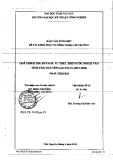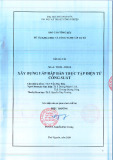
BioMed Central
Page 1 of 9
(page number not for citation purposes)
Head & Face Medicine
Open Access
Research
Histological analysis of the effects of a static magnetic field on bone
healing process in rat femurs
Edela Puricelli*†1, Lucienne M Ulbrich†2, Deise Ponzoni†2 and João Julio da
Cunha Filho†2
Address: 1Oral and Maxillofacial Surgery Unit, Hospital de Clinicas de P.A., School of Dentistry, UFRGS, Porto Alegre, RS, Brazil and 2Dept. of Oral
Maxillofacial Surgery, School of Dentistry, UFRGS, Porto Alegre, RS, Brazil
Email: Edela Puricelli* - epuricelli@uol.com.br; Lucienne M Ulbrich - lmulbrich@yahoo.com; Deise Ponzoni - deponzoni@yahoo.com;
João Julio da Cunha Filho - jjulio.voy@terra.com.br
* Corresponding author †Equal contributors
Abstract
Background: The aim of this study was to investigate, in vivo, the quality of bone healing under
the effect of a static magnetic field, arranged inside the body.
Methods: A metallic device was developed, consisting of two stainless steel washers attached to
the bone structure with titanium screws. Twenty-one Wistar rats (Rattus novergicus albinus) were
used in this randomized experimental study. Each experimental group had five rats, and two animals
were included as control for each of the groups. A pair of metal device was attached to the left
femur of each animal, lightly touching a surgically created bone cavity. In the experimental groups,
washers were placed in that way that they allowed mutual attraction forces. In the control group,
surgery was performed but washers, screws or instruments were not magnetized. The animals
were sacrificed 15, 45 and 60 days later, and the samples were submitted to histological analysis.
Results: On days 15 and 45 after the surgical procedure, bone healing was more effective in the
experimental group as compared to control animals. Sixty days after the surgical procedure,
marked bone neoformation was observed in the test group, suggesting the existence of continued
magnetic stimulation during the experiment.
Conclusion: The magnetic stainless steel device, buried in the bone, in vivo, resulted in increased
efficiency of the experimental bone healing process.
Background
Bone neoformation is of primary importance for the suc-
cess of dental clinical-surgical treatments. Much attention
has been given to the research of new strategies to improve
oral maxillofacial surgical techniques, as well as on the
knowledge and application of biomaterials [1] an their
possible chemical and physical consequences on the
patients.
Electromagnetic fields have been used for the stimulation
of bone neoformation processes. Their effects are
observed in the treatment of osteoporosis, osteonecrosis,
osteotomized areas, integration of bone grafts and post-
traumatic pseudarthrosis [2]. Several cell functions were
also shown to be influenced by electromagnetic fields
[3,4]. Electromagnetism affects osteogenesis through
mechanisms such as neovascularization, collagen produc-
Published: 24 November 2006
Head & Face Medicine 2006, 2:43 doi:10.1186/1746-160X-2-43
Received: 15 February 2006
Accepted: 24 November 2006
This article is available from: http://www.head-face-med.com/content/2/1/43
© 2006 Puricelli et al; licensee BioMed Central Ltd.
This is an Open Access article distributed under the terms of the Creative Commons Attribution License (http://creativecommons.org/licenses/by/2.0),
which permits unrestricted use, distribution, and reproduction in any medium, provided the original work is properly cited.






























